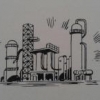Latest Downloads
-
 Water Bath Indirect Heaters
Water Bath Indirect HeatersArt Montemayor - Oct 12 2018 02:35 PM
-
 Petroleum: A Primer for Kansas
Petroleum: A Primer for KansasArt Montemayor - Oct 12 2018 02:27 PM
-
 Spray Tower for Flue Gas Scrubbing Design
Spray Tower for Flue Gas Scrubbing Designankur2061 - May 02 2018 02:31 PM
-
 Selection of Vertical Tanks
Selection of Vertical Tanksankur2061 - Apr 19 2018 07:42 AM
-
 Pressure Drop Calculator for Strainers 1
Pressure Drop Calculator for Strainers 1ankur2061 - Mar 24 2017 02:04 PM
-
 Horizontal Pig Trap System Design Guidelines
Horizontal Pig Trap System Design Guidelinesankur2061 - Jan 14 2017 02:54 PM
-
 Performance Prediction of 3-Stage Propane Refrigeration System
Performance Prediction of 3-Stage Propane Refrigeration Systemankur2061 - Aug 08 2016 02:43 PM
-
 Centrifugal Pump Troubleshooting Checklist
Centrifugal Pump Troubleshooting Checklistankur2061 - Dec 17 2015 08:18 AM
-
 Compressor Troubleshooting Checklist
Compressor Troubleshooting Checklistankur2061 - Sep 08 2015 11:43 AM
-
 Amine Sweetening Unit Preliminary Design
Amine Sweetening Unit Preliminary Designankur2061 - May 19 2015 09:35 AM
Popular Store Titles
 Tank Jacket Calculator
Tank Jacket Calculator
 Specification Sheet Collection
Specification Sheet Collection
 PIPESIZE
PIPESIZE
 Relief Valve Sizing
Relief Valve Sizing
 Rupture Disc Sizing
Rupture Disc Sizing
Chemical and Process Engineering Resources
Submitted Chris Haslego, Nov 21 2011 11:21 AM | Last updated Nov 21 2011 01:29 PM
| Category: | Equipment Design |
| Question: | What are some guidelines for sizing a PSV for a fire scenario on a vessel in a refinery service? |
| Keywords: | psv,sizing,refinery,service,fire,scenario,latent,heat,api |
| Answer: | Sizing a PSV on your vessel is a matter of calculating how much heat is inputted from the fire. API-520 uses Q = FA0.82 where Q is BTU/hr, F is the insulation factor (commonly taken as 1.0 but can be less than 1.0 if your insulation will remain effective during the fire and not be dislodged by fire hoses) and finally, A is the external area in ft2.The vapor load is then the total heat input from the fire divided by the liquid's latent heat (BTU/lb). As a fluid approaches its critical pressure, the latent heat as it boils decreases so the relieving flow rate increases. At the critical point, the latent heat goes to 0. Some companies simply use a minimum 50 BTU/lb latent heat, others look at depressuring equipment, etc. One point is the protection, or potential lack of it, provided by a PSV during a fire. The boiling liquid in the vessel from the fire helps keep the metal 'cool' so it retains its strength. Once the liquid is gone or the flame impinges on the wall not in contact with liquid, the metal can quickly reach a temperature where it has insufficient strength to withstand the internal pressure and you have a BLEVE. Not something you want to be around. Hence, the provision on some equipment to be able to depressure rather than relieving only on PSVs for protection during a fire.As an added point to the information above, if 50 Btu/lb is not your companies minimum standard for latent heat, here is an alternative to calculate the latent heat:If you want to try and determine latent heat the most accurate thing would be to take a process simulation tool such as PROII, HYSYS, winsim or the like. Set up a stream with the relevant composition and pressure and make a bubblepoint calculation (=the program calculates the temperature where the liquid starts to boil at the PSV set point P+allowable overpressure). Then add a heater to the stream with a specified duty e.g. The resulting vapour stream and the duty that you specified can now be used to calculate the latent heat. Important: You have to specify a relatively low heat input because you want the latent heat for the first fraction that boils off |
Forum Quick Links
Tech Q & A Category List
-
 Bulk Solids
Bulk Solids
-
 ChE Outside the Plant
ChE Outside the Plant
-
 Chemical Process Business
Chemical Process Business
-
 Chemistry Basics
Chemistry Basics
-
 Corrosion
Corrosion
-
 Equipment Design
Equipment Design
-
 Experimentation and Testing
Experimentation and Testing
-
 Fluid Dynamics
Fluid Dynamics
-
 Heat Transfer Technology
Heat Transfer Technology
-
 Industrial Utilities
Industrial Utilities
-
 Mass Transfer
Mass Transfer
-
 Physical Property Information
Physical Property Information
-
 Plant Basics
Plant Basics
-
 Plant Economics
Plant Economics
-
 Preparing to Become an Engineer
Preparing to Become an Engineer
-
 Process Control
Process Control
-
 Reactions and Processes
Reactions and Processes
-
 Refining
Refining
-
 Safety
Safety
-
 Separation Technology
Separation Technology
-
 The Environment
The Environment
-
 Thermodynamics
Thermodynamics

 FB
FB



0 Comments